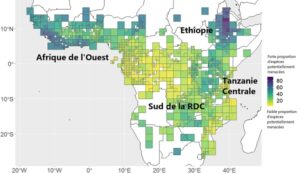Context

A., Droissart, V., Harris, D. J., … & Couvreur, T. L. (2019).
A third of the tropical African flora is potentially threatened
with extinction. Science advances, 5(11), eaax9444.
The Central African region, encompassing the Congo River Basin, is of critical global importance for the future of the biosphere and of humanity.
Currently, this geostrategic area is undergoing accelerated changes related to population growth and economic development with associated infrastructure needs and increasing pressures on land and natural resources. The Congo River Basin is home to the second largest area of tropical forests in the world (2.5 million km2). These forests represent an invaluable part of tropical biodiversity.
The world’s tropical forests are essential for maintaining environmental quality across the region, while providing local and international goods and services, as illustrated in CAFI’s new film, ‘The Forests of Central Africa: the key to a cooler future for all” (http: //www.cafi.org) and presented during the “One Planet Summit” (https://www.cafi.org/content/cafi/en /home/events/new-cafi-movie-calls-for-joint-action.html). Central Africa is thus at the center of global threats and challenges.
It is argued that climate change has the potential to negatively affect these forests. However, little is understood about the forests of Central Africa, how the current climate supports them, and how climate change will affect them. Nevertheless, Central Africa remains one of the least studied regions of the world. Therefore, data and knowledge gaps are significant. This not only jeopardizes advances in cognitive science on issues of global importance, but also hampers the design of robust and cost-effective programs for sustainable development, climate change mitigation and biodiversity conservation.
The numerous environmental challenges with which Central Africa is confronted fall within the framework of the Sustainable Development Goals (priority SDGs 6, 7, 13, 14 and 15), commitments made at COP 21 (closely linked in Central Africa to Reduction of Emissions resulting from Deforestation and Degradation, REDD) and One Health and 4 per 1000 initiatives, key elements of the IRD’s strategic orientations.
GOALS
The LMI DYCOFAC is a joint international laboratory linking the IRD, the IRGM and the UY1. Hosted in Cameroon, it brings together scientists from Central African countries, mainly Cameroon and Gabon, and Northern countries (France, United Kingdom, Belgium and USA).
It aims to continue and develop research activities both on the critical zone (permeable layer of the Earth close to the surface of the treetops down to the bottom of the water table. It is a living boundary layer, breathing and evolving water, air and living things interact) and water resources from co-constructed interdisciplinary projects. The main objective is to study the links between climate change and land use through the dynamics of plant cover and biogeochemical cycles. These links, whether forcings or responses, are complex, insufficiently studied and poorly quantified in the terrestrial forest ecosystems of Central Africa. They must be treated in an integrated manner at different spatial and temporal scales. Thus, research activities on the properties and processes of the critical zone must be integrated in order to collect spatially dense and temporally extended datasets. This involves the use of disciplines such as climatology, ecology, hydrology, geochemistry and geography.
The other objective of the LMI DYCOFAC is to train doctoral and post-doctoral students from the South and the North in and through research. It also aims to train technicians and engineers for the maintenance of observatories, analysis and modeling platforms.
Scientific and societal questions
- How is the climate changing in Central Africa?
- How to design/adapt models to integrate results from separate reference sites and monitoring networks?
- How to revalorize the results on water and biogeochemical cycles from reference situations?
- How can land use and land cover changes be safely tracked and represented in landscapes retaining extensive vegetative covers?
- How to share scientific results with communities, operational bodies (agencies, NGOs, companies) and decision-makers?
International networking

The LMI DYCOFAC is part of the current international scientific dynamic to federate research and innovation activities on the mass balance and the processes of the Critical Zone, and to insert them into the observation networks of terrestrial ecosystems (OZCAR, CZEN, eLTER). Many LMI participants are also members of the FRIEND AOC, IHP/UNESCO program. FRIEND is an international program designed to strengthen partnerships between regional hydrologists through conferences, workshops, training sessions. The LMI is therefore a structuring tool for the Central Africa partnership with the aim of studying the functioning and dynamics of forest and freshwater ecosystems in the Congo Basin sensu lato in a context of global change.

